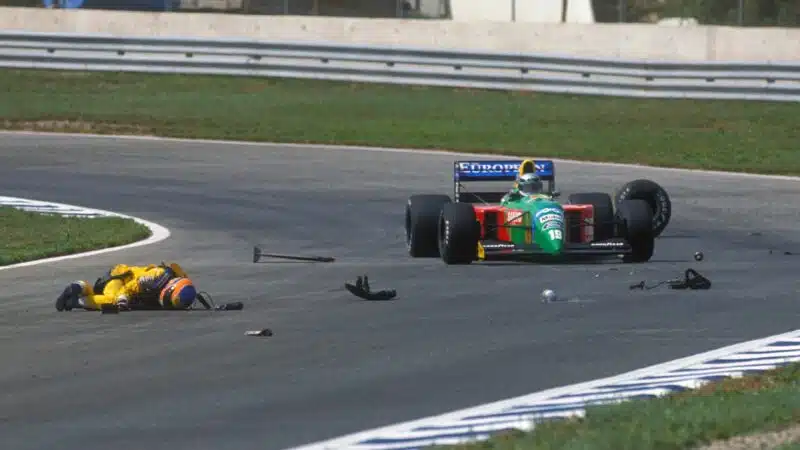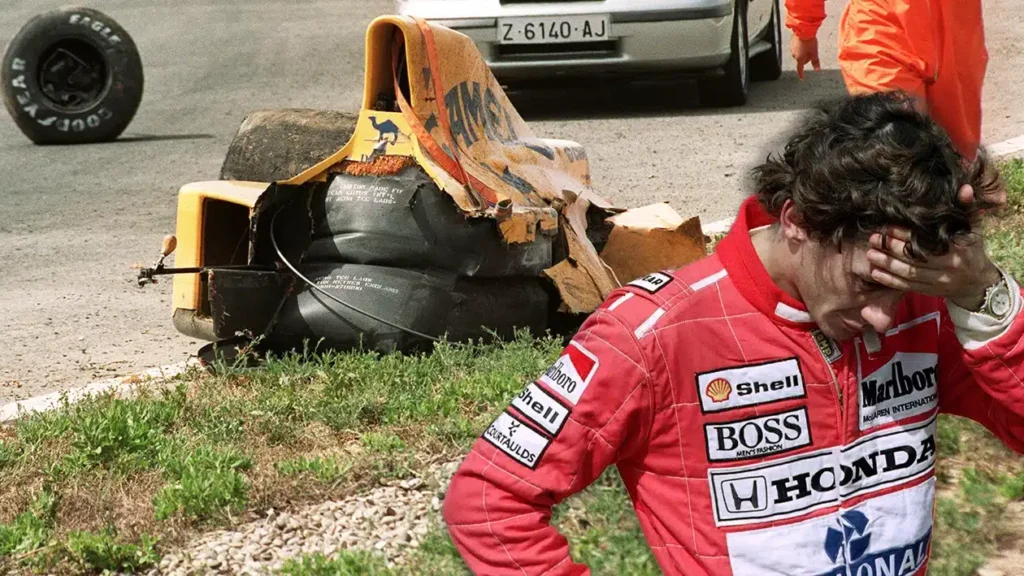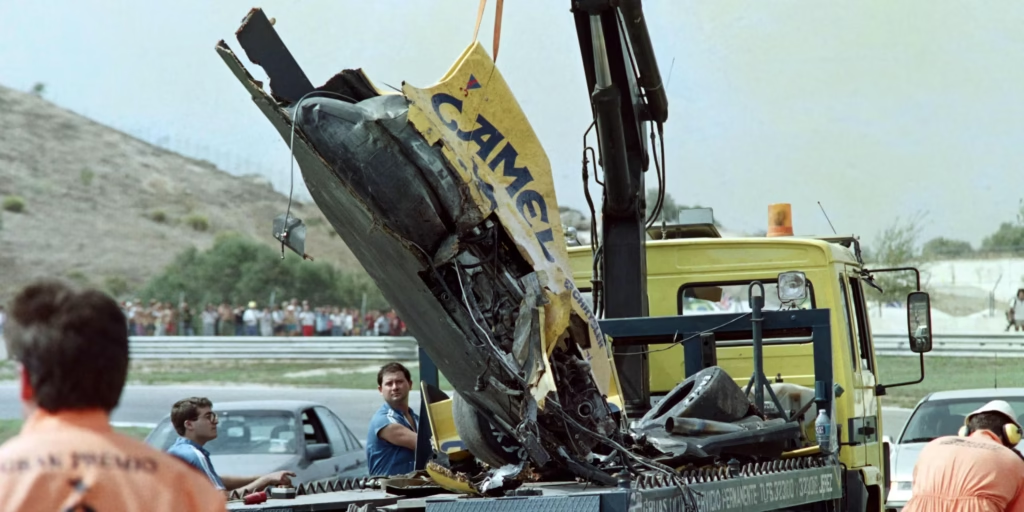The Devastating Real-Life Crash That Inspired ‘F1’: The Tragedy Behind the Speed

The Netflix series F1: Drive to Survive has brought the glamour, danger, and drama of Formula One (F1) to a massive global audience. But beneath the surface of cutting-edge cars and celebrity drivers lies a history laced with unimaginable tragedy, the most haunting of which inspired some of the most pivotal safety reforms in the sport’s modern era.
Among the many crashes that have scarred F1’s history, one stands out—not just for its horror, but for the profound changes it brought: the crash of Ayrton Senna at the 1994 San Marino Grand Prix. This real-life catastrophe not only ended the life of a legendary driver but also shocked the world into rethinking the meaning of speed, safety, and mortality in motorsport.
🏁 Setting the Stage: Formula One in the 1990s
By the early 1990s, Formula One was reaching new levels of speed and engineering sophistication. The cars were lighter, the engines more powerful, and driver skill remained paramount. But safety was still shockingly underdeveloped by today’s standards.
Context:
- Tracks had minimal runoff areas.
- Crash barriers were outdated or inconsistent.
- Helmets and protective gear were improving, but not foolproof.
- Teams prioritized speed and innovation over driver welfare.
The sport was dangerous by nature, but many believed its heroes were untouchable—until May 1994 shattered that illusion.

⚠️ The 1994 San Marino Grand Prix: A Weekend of Horror
Held at the Autodromo Enzo e Dino Ferrari in Imola, Italy, the 1994 San Marino Grand Prix is now remembered as the darkest weekend in F1 history.
Friday, April 29 – Rubens Barrichello Crash
- Young Brazilian driver Rubens Barrichello lost control and slammed into a barrier at high speed.
- His car flipped and smashed into a fence.
- He was knocked unconscious but survived with a broken nose and bruises.
It was a frightening start, but nothing could have prepared the world for what came next.
Saturday, April 30 – Roland Ratzenberger Dies
- During qualifying, Austrian driver Roland Ratzenberger, racing for the Simtek team, suffered a front-wing failure at nearly 190 mph.
- His car went straight into a concrete barrier at the Villeneuve Curve.
- Ratzenberger died instantly from a basilar skull fracture.
This was the first death during an F1 race weekend in 12 years, shocking the paddock—but not halting the race.
Sunday, May 1 – Ayrton Senna’s Fatal Crash
On race day, Ayrton Senna, three-time world champion and Brazilian national hero, started from pole position. He had been deeply shaken by Ratzenberger’s death and had reportedly contemplated not racing. But Senna, ever the competitor, took his place on the grid.
Just a few laps in, disaster struck.
The Crash:
- On Lap 7, at the high-speed Tamburello corner, Senna’s car veered off the track at 190 mph.
- It slammed into a concrete wall with massive force.
- His car came to a stop, and though it appeared relatively intact, Senna was slumped in the cockpit.
The Aftermath:
- He was airlifted to Bologna’s Maggiore Hospital.
- Shortly after 6:00 p.m., Ayrton Senna was pronounced dead. He had suffered a fatal head injury from a suspension component that pierced his helmet.

🇧🇷 The World Mourns a Legend
Senna’s death sent shockwaves across the world, especially in Brazil, where he was revered as more than a sportsman—he was a national symbol of hope and excellence.
- Over 3 million Brazilians flooded the streets for his funeral.
- President Itamar Franco declared three days of national mourning.
- Fellow drivers, fans, and sports legends around the globe paid tribute.
Senna wasn’t just a racer; he was the face of F1, and his loss changed the sport forever.
⚖️ The Aftermath: Legal, Technical, and Cultural Reforms
The 1994 Imola weekend forced F1 authorities to confront the sport’s deadly realities.
1. Safety Overhaul
- The FIA (Fédération Internationale de l’Automobile) introduced sweeping reforms.
- Cockpits were redesigned for greater head protection.
- Head and neck support (HANS) devices became mandatory.
- Runoff areas and crash barriers were modernized across circuits.
2. Changes in Race Governance
- Speed reduction measures were imposed, including aerodynamic limitations and fuel bans.
- Medical teams and rapid response systems were upgraded.
3. Track Redesign
- Tamburello, where Senna died, was reprofiled into a chicane.
- Multiple circuits were adjusted to prevent high-speed, head-on impacts.
4. Legal Proceedings
- Williams Racing, Senna’s team, faced a manslaughter investigation.
- After years of trials, no individuals were held criminally responsible, but the process highlighted lapses in team accountability.
🎬 The Cultural Legacy and Media Depiction
The story of Ayrton Senna’s life and death has inspired:
- Documentaries (notably Senna [2010], directed by Asif Kapadia)
- Books, including The Death of Ayrton Senna by Richard Williams
- Countless tributes in art, film, and even theology—Senna’s humility and faith were key to his identity.
In the F1: Drive to Survive series and the upcoming Brad Pitt F1 film, the legacy of drivers like Senna looms large. The fear, the risks, and the sacrifice they endured are part of what makes F1 as thrilling as it is tragic.
🧠 Why the Crash Still Matters
Senna’s death remains the last fatal crash during an F1 race weekend until 2014 (when Jules Bianchi succumbed to injuries from a crash in Japan). In many ways, that’s because of Senna.
His tragedy redefined the sport’s commitment to safety without eroding its edge or excitement. In a world obsessed with speed and competition, Senna’s death was a reminder of human vulnerability—and the price of greatness.

🔚 Conclusion: The Crash That Changed Everything
Ayrton Senna’s fatal accident in 1994 was not just a personal or national loss—it was a turning point in the history of motorsport. It revealed the fine line between heroism and hubris, between victory and vulnerability. The crash that inspired F1’s most emotional reform became a symbol of renewal.
The sport has never forgotten. And every race, every turn, every roar of an engine carries echoes of that one devastating moment that changed F1 forever.




